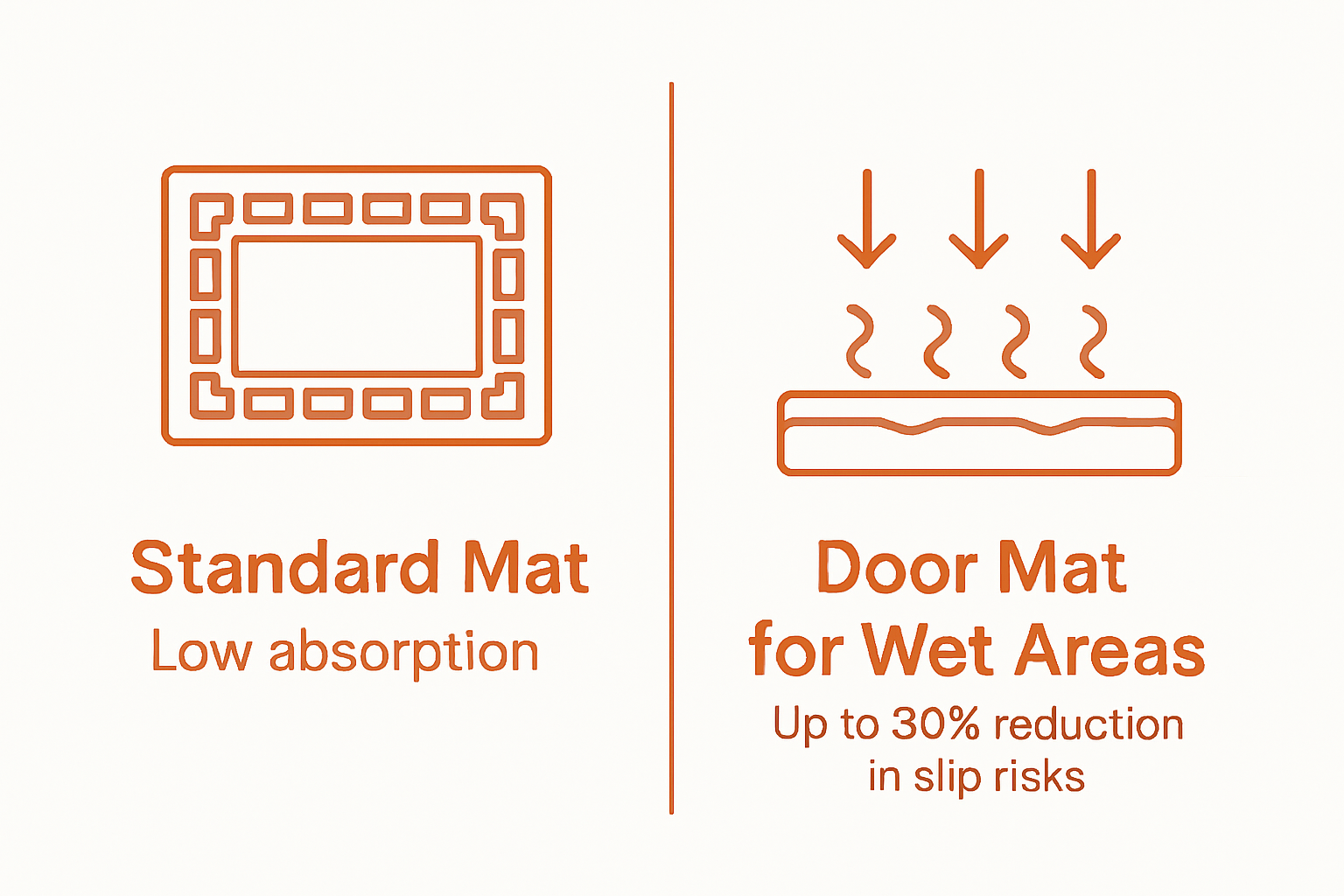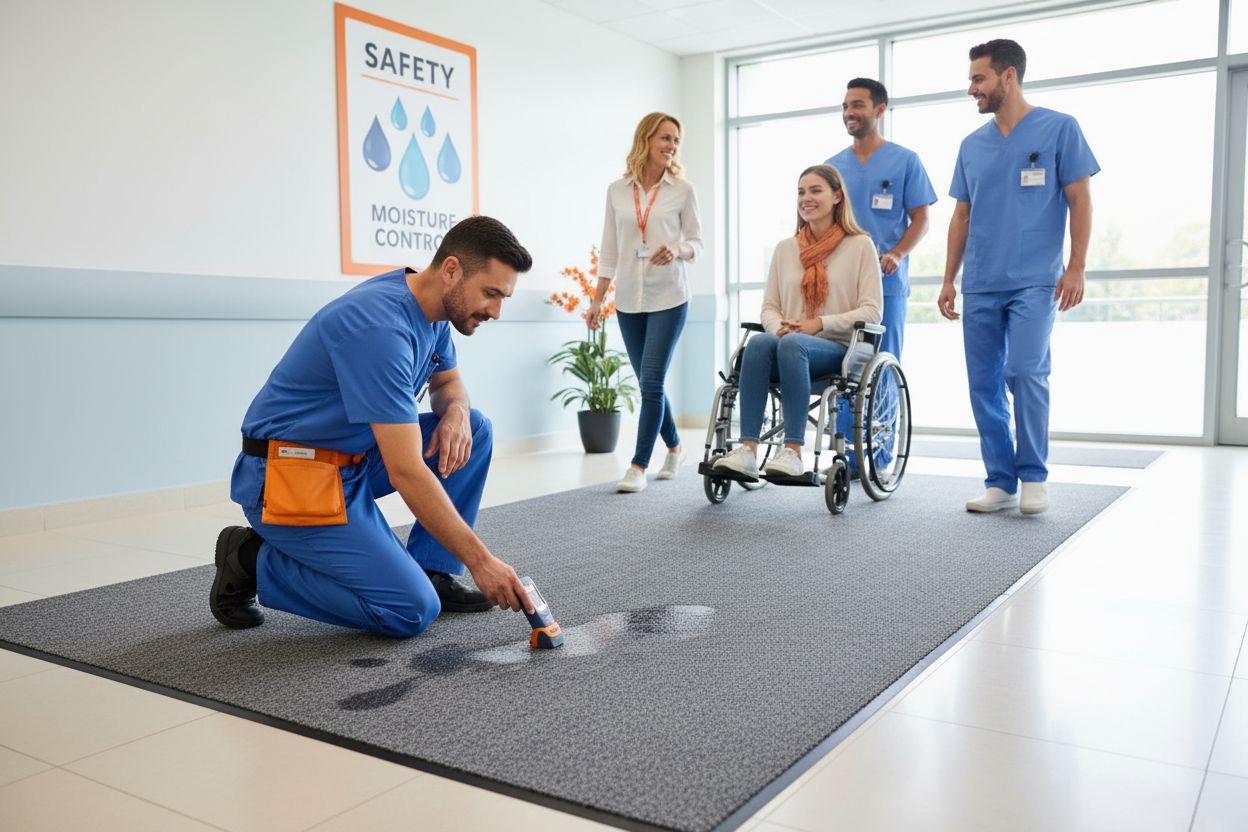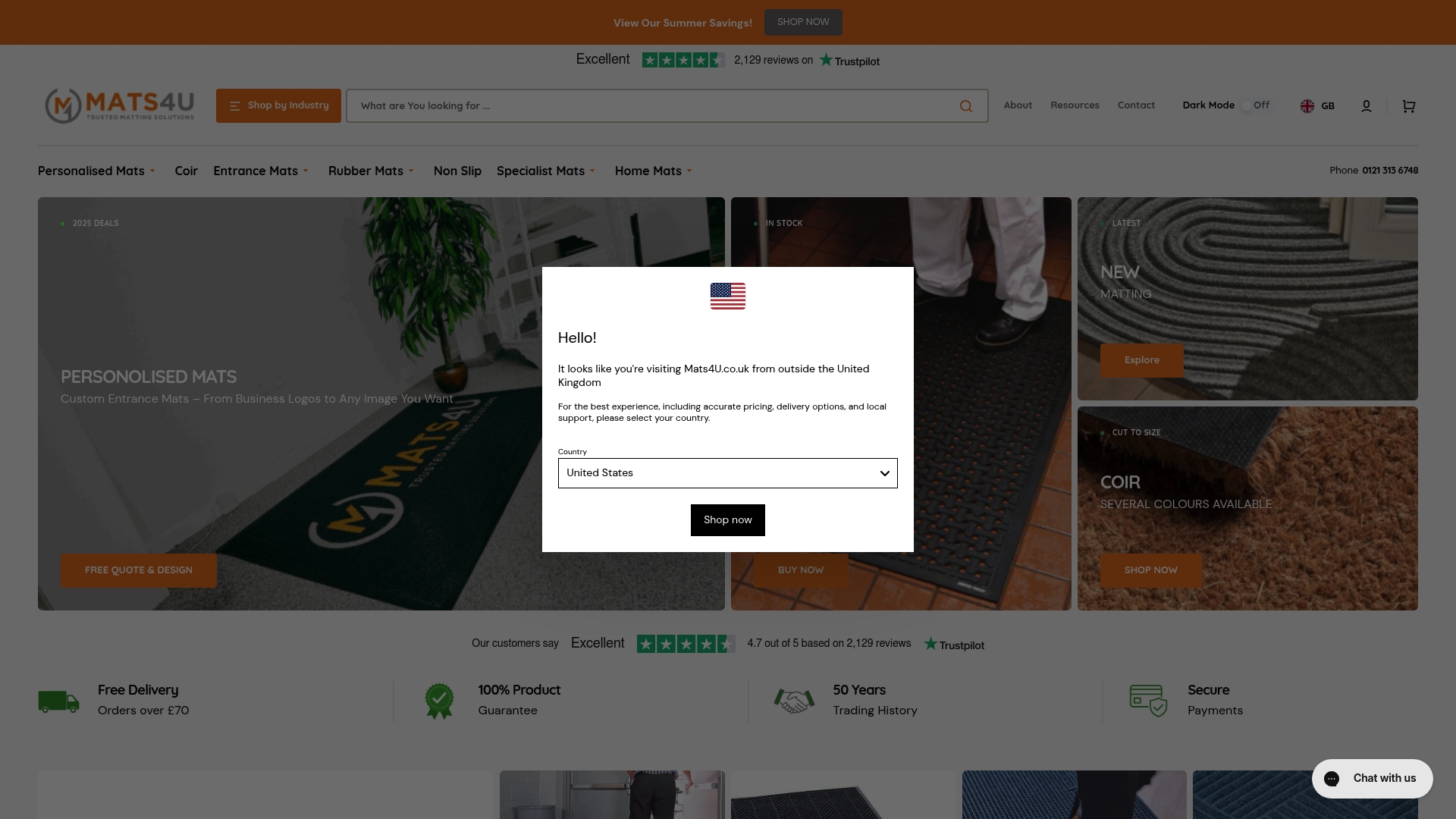Walk into any public building on a rainy day and you will notice the entrance mats working overtime. These unsung heroes are put to the test every time someone steps in with wet shoes or muddy boots. Yet, most people do not realise that professional-grade wet area mats can actually reduce slip risks by up to 90 percent in UK commercial environments. The best part is that it is not just about stopping puddles—these mats are engineered for hygiene, longevity, and safety you can feel underfoot.
Table of Contents
- What Are Door Mats For Wet Areas?
- The Importance Of Door Mats In Wet Environments
- How Door Mats For Wet Areas Work To Mitigate Risks
- Key Features And Materials Of Effective Door Mats
- Real-World Applications Of Door Mats In Various Sectors
Quick Summary
| Takeaway | Explanation |
|---|---|
| Specialised design for moisture capture | These mats are engineered with advanced materials to absorb water and prevent tracking dirt indoors. |
| Enhances safety by minimising slip risks | Well-designed mats can reduce slip accidents by up to 90%, ensuring safer environments for foot traffic. |
| Prolongs floor life and reduces cleaning | By capturing moisture and debris, these mats lessen the frequency of floor cleaning and extend the lifespan of surfaces. |
| Critical in various sectors like healthcare | In settings like hospitals, these mats help maintain hygiene and prevent cross-contamination effectively. |
| Multilayer construction maximises effectiveness | Effective mats include multiple layers for water absorption, moisture wicking, and non-slip backing to enhance functionality. |
What Are Door Mats for Wet Areas?
Door mats for wet areas are specialised floor coverings designed to capture moisture, dirt, and debris at entry points, preventing these elements from being tracked further into buildings. Unlike standard decorative mats, these functional solutions are engineered with specific materials and construction techniques to effectively manage water and maintain clean, safe environments.
Functional Design and Purpose
The primary objective of door mats for wet areas is moisture management. These mats are strategically placed at building entrances to intercept water droplets, snow, mud, and other wet contaminants that visitors might bring inside. Read our comprehensive guide on entrance mat solutions to understand how these essential products protect interior floors.
Key characteristics of effective wet area door mats include:
- High absorbency materials like microfibre or specialised synthetic blends
- Quick drying capabilities to prevent bacterial growth
- Slip resistant backing to ensure safety during wet conditions
- Durable construction capable of withstanding high foot traffic
Material Composition and Performance
Manufacturers of door mats for wet areas utilise advanced materials specifically chosen for moisture management. According to UK Health and Safety Executive research, professional entrance matting can reduce slip risks by up to 90% in commercial environments.
 These mats often incorporate multiple layers:
These mats often incorporate multiple layers:
- Top layer: Highly absorbent fibres designed to rapidly capture water
- Middle layer: Moisture wicking material that prevents liquid pooling
- Base layer: Non slip rubber or vinyl backing to secure mat position
The engineering behind these mats transforms potential safety hazards into controlled entry zones, protecting floors and reducing maintenance requirements in schools, offices, retail spaces, and industrial settings across the United Kingdom.
The Importance of Door Mats in Wet Environments
Door mats in wet environments serve critical functions beyond simple aesthetic decorations, playing a vital role in maintaining safety, hygiene, and operational efficiency across various commercial and institutional settings. These specialised floor coverings act as the first line of defence against moisture, dirt, and potential slip hazards.
Safety and Risk Management
In wet environments, entrance mats are instrumental in preventing accidents and reducing workplace liability. Learn more about preventing entrance mat failures to understand their critical safety implications. According to the Health and Safety Executive, slips and trips constitute a significant proportion of workplace accidents, with wet floors being a primary contributor.
Key safety benefits include:
- Immediate absorption of water and moisture
- Reducing surface friction potential
- Creating a controlled transition zone between exterior and interior spaces
- Minimising potential slip and fall incidents
Hygiene and Maintenance Efficiency
Beyond safety, door mats in wet environments play a crucial role in maintaining cleanliness and reducing maintenance costs. By capturing moisture, dirt, and debris at entry points, these mats prevent contaminants from spreading throughout buildings. This proactive approach significantly reduces cleaning requirements and prolongs floor surface longevity.
Operational advantages encompass:
- Decreased floor cleaning frequency
- Reduced wear and tear on interior flooring
- Improved overall facility appearance
- Extended lifespan of interior floor surfaces
In sectors such as healthcare, education, retail, and industrial environments, the strategic placement of high performance door mats becomes an essential element of comprehensive facility management, protecting both human safety and infrastructure investment.
How Door Mats for Wet Areas Work to Mitigate Risks
Door mats for wet areas are sophisticated engineered solutions designed to systematically reduce environmental risks through strategic moisture interception and management. By understanding their intricate mechanical and material properties, organisations can implement robust preventative strategies against potential workplace hazards.
Moisture Absorption Mechanisms
These specialised mats operate through advanced moisture management technologies that extend far beyond simple fabric coverings. Check out our winter entrance mat strategies to understand comprehensive risk mitigation techniques. According to research from Safety and Health Magazine, entrance mats can significantly reduce slip potential by creating controlled transition zones.
Core moisture absorption mechanisms include:
- Multi layered fibrous structures with high capillary action
- Hydrophilic material compositions that rapidly trap water molecules
- Textured surface designs maximising liquid containment
- Engineered drainage channels preventing surface liquid accumulation
Biomechanical Risk Reduction
Door mats for wet areas are scientifically designed to interact with human movement patterns, mitigating potential slip and fall incidents through precision engineering. By understanding pedestrian traffic flow and interaction points, manufacturers create mats that fundamentally alter risk dynamics.
Risk reduction strategies encompass:
- Creating increased surface friction compared to standard flooring
- Providing visual and tactile cues signalling transition zones
- Interrupting potential liquid migration pathways
- Distributing pedestrian weight across specialised textured surfaces
The sophisticated engineering behind these mats transforms potential environmental hazards into controlled, manageable entry experiences, protecting both human safety and organisational infrastructure across commercial, educational, and industrial settings throughout the United Kingdom.
Key Features and Materials of Effective Door Mats
Effective door mats for wet areas represent a complex interplay of material science, engineering precision, and practical design considerations. Their performance goes far beyond simple fabric coverings, involving sophisticated technological approaches to moisture management and safety enhancement.
The following table summarises the key features and functions of effective door mats for wet areas, helping readers quickly compare their core attributes and benefits.
| Feature / Function | Description |
|---|---|
| High Absorbency Materials | Utilises microfibre or specialised synthetic blends designed to rapidly capture moisture. |
| Quick Drying Capabilities | Dries fast to prevent bacterial growth and unwanted odours. |
| Slip Resistant Backing | Non-slip rubber or vinyl backing ensures mats stay securely in place, even when wet. |
| Durable Construction | Engineered to withstand high foot traffic in busy settings. |
| Multilayered Structure | Includes distinct layers for absorption, wicking, and stability. |
| Debris and Dirt Capture | Effectively traps debris at entry points to maintain interior cleanliness. |
| Easy Maintenance | Designed for straightforward cleaning and sanitation protocols. |
Material Composition and Performance
The selection of materials determines a door mat’s ability to manage moisture and maintain safety in challenging environments. Learn more about maintaining your commercial mats to understand the importance of material selection. According to Health and Safety Executive guidelines, effective entrance matting requires specific material characteristics to minimise workplace risks.
Critical material considerations include:
- High tensile strength synthetic fibres
- Rapid moisture wicking capabilities
- Resistance to microbial growth
- UV and chemical degradation resistance
- Colour fastness under repeated washing
Structural Design and Engineering
Beyond material selection, the structural engineering of door mats plays a crucial role in their effectiveness. Manufacturers employ advanced design techniques to maximise moisture capture and reduce slip potential. The mat’s physical architecture determines its performance in managing water, dirt, and potential workplace hazards.
Key structural design elements encompass:
- Multi layered construction with distinct moisture management zones
- Precision engineered surface textures
- Graduated drainage channels
- Non slip backing systems
- Bevelled edges to prevent tripping
The intricate design of these specialised floor coverings transforms them from simple decorative elements into critical safety infrastructure, protecting both human movement and facility environments across commercial, industrial, and institutional settings throughout the United Kingdom.
Real-World Applications of Door Mats in Various Sectors
Door mats for wet areas serve far more than decorative purposes, functioning as critical infrastructure across diverse professional environments. Their strategic implementation addresses specific operational challenges unique to different industrial and institutional contexts, transforming potential safety risks into managed entry zones.
Healthcare and Clinical Environments
Explore commercial entry door mat solutions to understand sector specific requirements. According to NHS Infection Control Guidelines, entrance matting plays a crucial role in maintaining sterile environments by intercepting contaminants and reducing cross infection potential.
Specific healthcare application requirements include:

- Antimicrobial material compositions
- Rapid moisture absorption capabilities
- Easy sanitisation protocols
- Minimal particle generation during use
- Compliance with stringent hygiene standards
Industrial and Manufacturing Settings
In industrial environments, door mats transition from safety accessories to essential workplace protection mechanisms. These specialised floor coverings manage multiple risk factors simultaneously, protecting both personnel and facility infrastructure from potential hazards introduced through foot traffic.
Critical industrial application considerations encompass:
- Chemical resistance properties
- Heavy duty material construction
- Enhanced slip prevention technologies
- Durability under extreme environmental conditions
- Compatibility with safety marking systems
These engineered solutions demonstrate remarkable versatility, protecting human movement and organisational assets across education, healthcare, manufacturing, retail, and service environments throughout the United Kingdom by systematically managing moisture and potential contamination risks at critical entry points.
This table contrasts the critical requirements for door mats used in healthcare and industrial environments, making it easier to distinguish sector-specific needs at a glance.
| Sector | Key Requirements |
|---|---|
| Healthcare and Clinical | Antimicrobial materials, rapid moisture absorption, easy sanitisation, minimal particle generation, strict hygiene |
| Industrial and Manufacturing | Chemical resistance, heavy-duty durability, advanced slip prevention, withstands harsh conditions, safety marking |
Protect Your Space from Wet Area Hazards Today
If keeping moisture, dirt and safety risks away from your building entrances is a constant challenge, you are not alone. Wet areas can lead to slips, messy floors and extra cleaning time, especially in busy environments that demand high standards. As discussed above, controlling water and debris at the door is essential for maintaining clean, safe and efficient spaces.
Discover how our Indoor Entrance Mats can help you capture moisture and provide the reliable barrier your entrances desperately need. These mats are designed using the latest absorbent materials and slip-resistant technology.

Ready to minimise maintenance headaches and boost safety at every entry? Visit Mats4U today and explore matting solutions trusted by organisations throughout the UK. We offer practical advice, custom sizing and fast delivery so you can address wet area risks with confidence. Make your first impression safe, clean and professional now.
Frequently Asked Questions
What are door mats for wet areas?
Door mats for wet areas are specialised mats designed to capture moisture, dirt, and debris to prevent these elements from being tracked into buildings. They are engineered with materials that promote high absorbency and quick drying, helping to maintain clean and safe environments.
How do door mats for wet areas improve safety?
These mats enhance safety by immediately absorbing water and moisture, reducing slip and fall risks. They create a controlled transition zone between the outdoors and indoors, minimising the potential for accidents caused by wet floors.
What materials are commonly used in door mats for wet areas?
Effective door mats often consist of high absorbency materials like microfibre or synthetic blends, with a non-slip rubber or vinyl backing. These materials are designed for durability and moisture management, ensuring safety and longevity.
Can door mats for wet areas help with hygiene?
Yes, door mats contribute significantly to hygiene by trapping dirt and contaminants at entry points, preventing them from spreading throughout the building. This proactive measure reduces cleaning frequency and prolongs the lifespan of floor surfaces.









